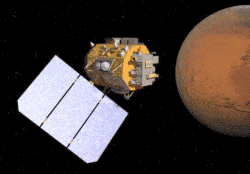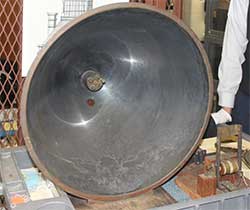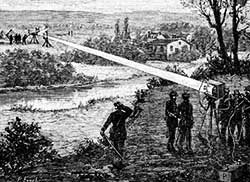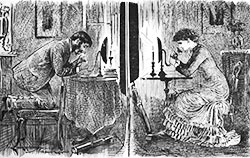The Photophone and Interplanetary Communication.

Communication with Mars today is a little like yesteryear’s dial-up modems — channels are slow and crowded. NASA is planning to address this problem with satellites that use lasers to relay deep space messages to Earth. Signaling by light rather than radio waves will provide sufficient bandwidth for high definition video transmissions between Mars and Earth.2
Beaming messages on rays of light seems very au courant, but Alexander Graham Bell actually did it in 1880. He called his invention the photophone and considered it, not the telephone, his greatest achievement.3
How It Worked. Bell’s telephone worked something like this: Sound waves striking the transmitter produced an electric current by moving a diaphragm connected to wire coils. The current varied in keeping with the sounds and was carried by wire to the receiver, where it moved a diaphragm in sync with the one in the transmitter. It was a little like a child’s tin can telephone, except the vibrations were converted into electricity and back again.
The photophone worked similarly, except the signal was sent on rays of light rather than through wires. The intensity of the light varied in keeping with the sounds striking the transmitter. The light was aimed at a selenium plate in the receiver, which increased the electric flow as the light got brighter. This current then drove the receiver’s diaphragm to reproduce the original sound.
The Photophone Is Born. Bell heard how selenium’s electric conductivity varies with its exposure to light a few years after he developed the telephone. He was immediately struck by the intriguing possibilities this provided for wireless telephony.

By this point Bell was world famous with his own laboratory and staff, quite a step up from the obscure university professor who had introduced the telephone just a few years earlier. By the winter of 1880, he had a working unit. Conscious of the litigation and controversy surrounding his telephone patent, he placed a working photophone in a sealed box that was delivered to the Smithsonian Institution with instructions that it be opened only upon his direction.
Bell was so pleased with his new invention that he introduced it as a member of his family. He wrote his father to report the birth of two babies in one week: one delivered by his wife on Sunday at home; the other born at his lab on Thursday. Both were strong and healthy, he said, and destined to grow to greatness. He closed by congratulating his father on being “the grandfather of the Photophone.”5

By summer 1880 the photophone was ready for introduction to the world. It needed sunlight and there were a frustrating series of cloudy days. Finally clear weather came on June 3, 1880. Bell positioned the receiver in a window at his lab pointing to a colleague stationed 700 feet away on the roof of the Franklin School. The demonstration began with a request that Bell wave his hat if he could hear the message. Bell vigorously waved his hat at the window.
Bell foresaw great things for his creation, envisioning its use in ship-to-ship communication at sea and military communications that could neither be interrupted nor intercepted. It also provided a means for lighthouses to identify themselves to passing vessels.
Further Development. Engineers at the Bell Telephone Company made a few improvements to Bell’s invention. By the early 20th century, Ernst Rühmer and others, working with improved light sources were able to achieve transmissions of 15 kilometers, sufficient for practical applications.
During World War II the German Army used a portable device called the Lichtsprechgerät (light speaking device) for military field communications. With the invention of the laser, engineers began to seriously re-explore light communications and eventually developed fibre optics to solve many of the problems of transmission through air.
 1881 Cartoon Shows Lovers Speaking Across the English Channel by Photophone.7
1881 Cartoon Shows Lovers Speaking Across the English Channel by Photophone.7The Photophone Captures the Public Imagination. There is something magical about light, so a device that carries speech on light beams is sure to capture public attention. Less than a year after the photophone’s introduction, a cartoon in the popular British magazine, Punch, showed Victor in France whispering to Angelina in England by photophone — whispering so that Anna Maria sleeping in the next room wouldn’t hear his voice.8
Not everyone, of course, was impressed. A New York Times columnist sarcastically noted that photophone users would hear each other as plainly as those using regular telephones, so both would say “‘Hullo,’ ‘What’s that?’ ‘Don’t hear,’ and ‘Speak louder’ until they [were] tired.” And while it was true that a photophone could “flash a sunbeam thirty miles,” it would be of little value if “there [were] hills, houses, or fat men in the way ….”9
The Photophone and Interplanetary Communication. It turns out NASA wasn’t the first to consider beaming messages to other planets. At least one nineteenth century astronomer, Camille Flammarion, mentioned it in commenting on the French Academy of Science’s acceptance of a 100,000 franc legacy to be awarded for successful two-way communication with another world. Flammarion thought it would be necessary to do more than just “photophone them, ‘Hello! are you there?’” He suggested communication by displaying a series of changing geometric shapes that could be viewed by telescope from the other world.10
-----
- Adapted from conceptual animation by NASA’s Goddard Space Flight Center, posted with article on NASA Taking First Steps Toward High-speed Space Internet on NASA web site.
- Ashley Hume, NASA Taking First Steps Toward High-Speed Space “Internet,” NASA web site.
- Information for this article comes from Wikipedia article on the Photophone; Ernst Walter Rühmer, Wireless (translated by James Erskine-Murray), D. Van Nostrand Company (1908).
- Parabolic receiver is in the collection of the Smithsonian Institution. Image from Replicating Bell’s 19th Century Photophone on the Princeton University web site.
- Letter from Alexander Graham Bell to Alexander Melville Bell dated February 26, 1880.
- Soldiers using a photophone to communicate across a river. From Émile Desbeaux, Physique Populaire, Fig. 116, p. 180, Librairie Marpon et Flammarion, Paris (1891),
- Cartoon by George du Maurier from Punch Magazine for December 13, 1880.
- Ibid.
- The Photophone, The New York Times, p. 4 (August 30, 1880).
- Camille Flammarion, Inter-Astral Communication, The New Review, vol. 6, pp 106-14 (1892).
This article originally appeared in our free semi-monthly newsletter. To receive future issues, please add your name to the subscription list.


